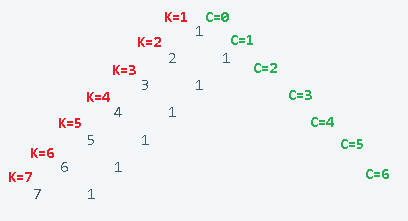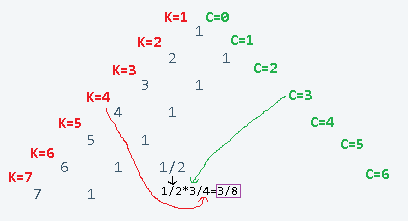1
2 1
3 1 2
4 1 1 6
5 1 2/3 3/2 24
6 1 1/2 2/3 3 120
7 1 2/5 3/8 8/9 15/2 720
This triangle has fascinated me for some time.
Since discovering it, I’ve been prying at all its little details, one by one.
First, how to build it? Let me start by going over the “columns” of the triangle.
Let the diagonal column from left to right be called column K, start from 1:

Let the diagonal column from right to left be called column C, start from 0:

Finally, let each row R start from 1:

Alright, now given K and C, we know the row R:

K + C = R
Alright now.. How do we build this thing?
Start off at C=0 and C=1, with the numbers 1,2,3,4,5,… and the number 1:

The algorithm for generation is:
For each top left number t, the bottom right number b will be:
b = t * C / K
(C and K are for b‘s position.)
Here are a few examples:


The generating function for any number becomes:
C!
———–
K C – 1
Now that we have the function for this triangle, what’s so special about it?
Starting with K=1, if we add the reciprocal of all the values together, we get the well known sum:
1 + 1 + 1/2 + 1/6 + 1/24 + 1/120 + 1/720 + … = e
If we sum the reciprocals of K=2, we get an interesting result:
1/2 + 1 + 1 + 2/3 + 4/12 + 8/60 + 18/360 + … = e2 / 2
For K=3, we get:
1/3 + 1 + 3/2 + 9/6 + 27/24 + 81/120 + … = e3 / 3
This can be generalized to:
The sum of the reciprocal of numbers from C = 0 to infinity is:
eK
——
K
Alright, if a sum was possible for all numbers in one column, perhaps we can come up with the sum of all numbers in the other column?
And indeed, the sum of the numbers from K = 0 to infinity is:
C! * Zeta(C – 1)
where Zeta is the Riemann zeta function
As an example, at C=3:
6 + 3/2 + 6/9 + 6/16 + 6/25 + … = 3! * Zeta(2) = π2
Cool, eh?
But the fun doesn’t stop there..
Let’s look at the products of individual rows:

Very interesting that the product of all these rows always equals 1.
This means the product of numerators equals the product of the denominators:
The product of n! from 1 to x
=
The product of (x – n + 2)n-1 from 1 to x
So for row 7 for example:
1! * 2! * 3! * 4! * 5! = 60 * 51 * 42 * 33 * 24
This isn’t very trivial, at least not to me, so I’ll show a proof:
The product of n! from 1 to x = G(x + 2)
where G(x) is the Barnes G function.
Using a known equivalence for G(x):
1! * 2! * 3! * 4! * … * x!
=
G(x + 2)
=
(x + 1)!x + 1
———————-
K(x + 2)
where K(n) is the K function.
I’ll use row 7 as an example, but this logic can be applied to any row:
1! * 2! * 3! * 4! * 5!
=
6!6
————————————–
11 * 22 * 33 * 44 * 55 * 66
We need to prove that the product of (5 – n + 2)n-1 from 1 to 5 is equal to this.
60 * 51 * 42 * 33 * 24
=?
6!6
————————————-
11 * 22 * 33 * 44 * 55 * 66
To make things easier, let’s get rid of 11 and 60 as these equal to 1.
51 * 42 * 33 * 24
=?
6!6
——————————–
22 * 33 * 44 * 55 * 66
Multiplying the denominator by both sides:
6!6
=?
22 * 33 * 44 * 55 * 66
*
51 * 42 * 33 * 24
Reverse the positions of the numbers, for easier readability:
6!6
=?
22 * 33 * 44 * 55 * 66
*
24 * 33 * 42 * 51
These numbers can now easily be multiplied together:
6!6
=?
26 * 36 * 46 * 56 * 66
Which is true! QED.
Thinking that’s all we can do with this triangle? Well think again!
We’ve found the product of each row, can we get the sum of each row?
I couldn’t figure out a formula for the sum of each number (let me know if you can!)
But I was able to come up with a formula for the sum of the reciprocal of each number.

Sum reciprocal of all values in a row R
=
Round((R – 1)! / ΩR))
———————————-
R!
Where Ω is the Omega constant.
As an example, at R=7, the sum of the reciprocal would be:
Round(6! / Ω7) / 7! = 38149 / 5040
If you’re wondering where the Omega constant came from, it has to do with the smallest number in each row.
Each row has a smallest number:

If you follow these set of numbers to an infinite row, the ratio of the position of the smallest number in the row will converge to:
Ω
——–
Ω + 1
…the constant equals about 0.36.
Once again, Ω is the Omega constant.
And from the right side of the triangle, it converges to:
1
——–
Ω + 1
Since this position converges linearly, we can say that the smallest number in any row will be at positions:
C = Round(R * Ω / (Ω + 1))
or
K = Round(R / (Ω + 1))
With all of these wonderful findings, you might wonder, is there a “binomial expansion” analog for the Factorial Triangle?
Is there some function that expands and uses the triangle values as coefficients?
Yes, somewhat. Check out the series expansion of: .. as n approaches n->0.
.. as n approaches n->0.
Here’s a wolframalpha link
The series follows the reciprocal triangle pattern:

I find this triangle quite fascinating.
If you find any other interesting curiosities with this triangle, please let me know!
Seems like an off by one error combined with sign inversion hides part of what we might consider the canonical version of this:
In your current version, we can’t directly see the values in column K0, but we indirectly can:
Kx=K1
Rx=R1
I=0
DO:
GOTO Kx,Rx
Write I
Rx=Rx+1
I=I+1
But the integers also contain negative numbers.
So, to account for this and to appeal to a sense of symmetry, how about this instead:
Kx=K1
Rx=R1
I=0
DO:
GOTO Kx,Rx
Write I
Rx=Rx+1
I=I-1
As a consequence, what we previously called C=1, we now have to call C=-1.
See if you can find new patterns by adding this K0 column to the pyramid, to match the fact that C0 makes the coordinate values of R and K, but not C, available from within the pyramid.
You might note that it now has 0 at R0,K0,C0 as the top of the pyramid, instead of 1 at R1,K1,C0 as the top of the pyramid.
You might also note that we can now expand the pyramid upwards, in mirror image form.
We might also note that this makes available a redundant ‘nega’version of the row numbering within the pyramid.
LikeLike